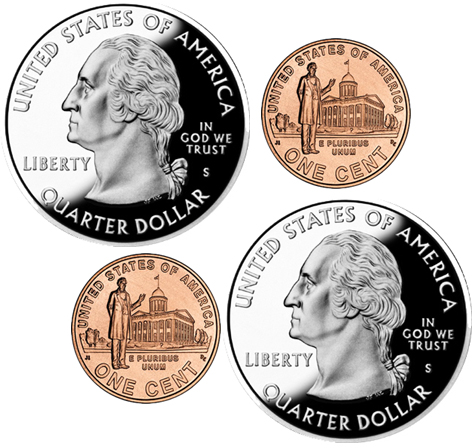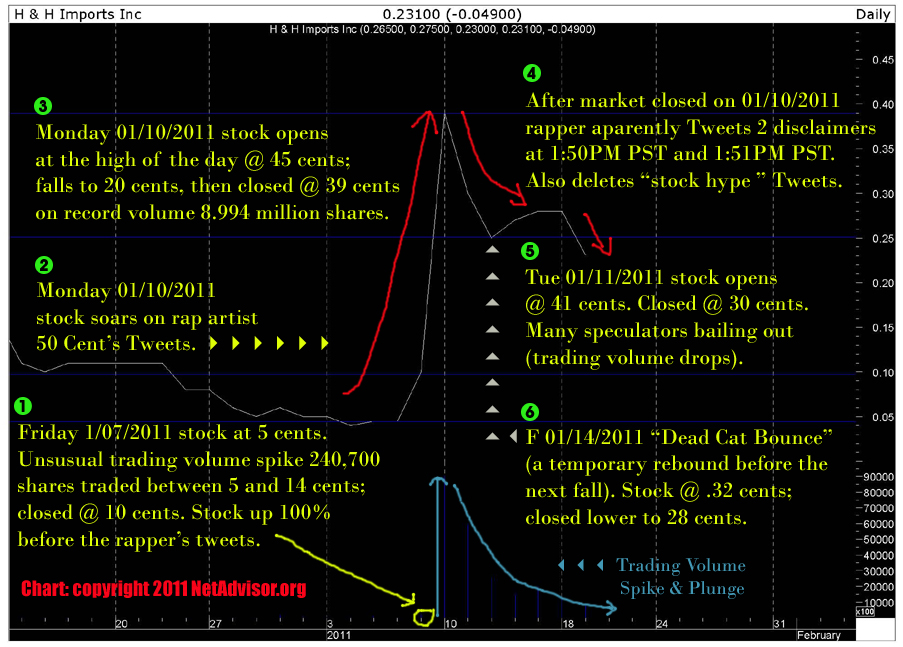01.20.2011

2 Cents on 50 Cent’s Twitter Stock Hype
Investor Education Series written by Net Advisor™
Background: Recently there was much fanfare regarding famed rap artist Curtis Jackson, otherwise known as 50 Cent to his fans. Jackson reportedly received 30 million shares of a money losing company in Florida called H&H Imports, Inc. (Source: NBC News/PDF). One could argue based on the current financials (Cash Flow, Balance Sheet) from the company, the shares are technically worthless. The company lost $1.3 million on its last quarterly earnings with $292,933 of revenue. As of September 30, 2010, company debt is climbing. In March 2010, the company’s own auditor questioned whether the company can “continue as a going concern” [Source: New York Post (PDF)].
Based on the company’s September 30, 2010 (unaudited) 10-Q Filing, the company shows some accounting that we would need more information to understand. The 10-Q shows “Deferred productions costs” and “Prepaid expenses” as assets. Normally a “cost” is a liability and an “expense” is money you pay, thus liabilities are not really assets. We invite the company CEO or CFO to clarify this for us.
According to finance.yahoo.com the company has 184,755,010 (or about 184 million) shares outstanding. As of this post date, the company somehow managed to have a market value of $48.51 Million. H&H is a penny stock, which are largely unregulated and thus are considered higher risk. Jackson however reportedly starts making money if the stock climbs to 15 cents or higher, and some warrants giving him options to buy the more stock reportedly cost him 10 cents a share [Source: New York Post (PDF)].

Jackson had gone onto the social networking site Twitter, where he made a serious of boats about suggesting to his some 3.8 million fans to buy H&H stock. The tweets were also captured on Jackson’s Twitter account by BusinessInsider.com and noted by Forbes that included statements such as,
“You can double your money right now. Just get what you can afford.”
— Source: BusinessInsider.com image of 50 Cent Twitter Account
On Monday January 10, 2011 the stock which closed at 10 cents the previous Friday (01-07-2011), opened up at 45 cents which was the high of the day and an all time high for this company. The result of the rapper’s Tweets? H&H stock soared 290% to close at 39 cents on record trading volume. Jackson saw a paper gain of about $8.7 Million [Source: New York Post (PDF)].
Anyone who bought this stock at Monday’s open of 45 cents would be down 48.88% if still held by Thursday’s 01-19-2011 close of 23 cents.
After the excitement was over and the hyped up penny stock Tweets came to a relative end. After the market closed on 01-10-2011, 50 Cent’s Twitter account posted two disclaimers:
@ 1:50PM PST – “I own HNHI stock thoughts on it are my opinion. Talk to financial advisor about it.” (61 people recirculated or (“re-tweeted”) this message to other followers.)
— Source: 50 Cent Twitter Account Post (PDF)
The second disclaimer came in within 1 minuet of the first:
@ 1:51 PM PST – “HNHI is the right investment for me it may or may not be right for u! Do ur homework” (59 people recirculated or (“re-tweeted”) this message to other followers.)
— Source: 50 Cent Twitter Account (PDF)
In addition, all of the major tweets hyping up the said stock were suddenly deleted from 50 Cent’s Twitter account. However copies of the tweets are still circulating on the web.
MS-NBC reported that what the rapper was not part of a “pump and dump scheme” since he says he did not sell his shares after hyping them up.
The SEC stated in 2001 that:
“Pump and dump” schemes, also known as “hype and dump manipulation,” involve the touting of a company’s stock (typically microcap companies) through false and misleading statements to the marketplace. After pumping the stock, fraudsters make huge profits by selling their cheap stock into the market.
Pump and dump schemes often occur on the Internet where it is common to see messages posted that urge readers to buy a stock quickly or to sell before the price goes down…
In reality, they may be company insiders or paid promoters who stand to gain by selling their shares after the stock price is “pumped” up by the buying frenzy they create. Once these fraudsters “dump” their shares and stop hyping the stock, the price typically falls, and investors lose their money.”
— Source: Securities & Exchange Commission (SEC.gov)
Compliance Issues?
Curtis Jackson may have not sold his stock says MS-NBC, but a lot of stock got bought and sold by people that day. One question that could be pursued is that even if Jackson did not sell shares, is there anyone whom he knew or was close to him who could have discussed these tweets prior to posting? That could be deemed as insider trading by those who profited from non-public information in this case knowing that the stock would be tweeted in the fashion that is was. This can be hard to prove and of course any violation of this SEC rule would just be denied.
Jackson, if not an officer of the company, may still be deemed as an “insider” or “affiliate (SEC Rule 405)” with owning just over 16% of the stock (30 million shares held divided by 184,775,010 shares outstanding).
Jackson may want to check with a securities lawyer before selling any of his shares in H&H. Under SEC Rule 144, insiders, affiliates or control persons are generally required to hold their stock for a minimum period before they can sell and can have other restrictions on how many shares and what total dollar value they can sell.
“Before you may sell any restricted securities in the marketplace, you must hold them for a certain period of time. If the company that issued the securities is subject to the reporting requirements of the Securities Exchange Act of 1934, then you must hold the securities for at least six months. If the issuer of the securities is not subject to the reporting requirements, then you must hold the securities for at least one year.”
— Source: SEC Rule 144 (SEC.gov)
As an insider, affiliate or control person, the rapper’s Twitter comments could arguably be deemed as inappropriate, but hard to say if any securities rules were broken. Jackson does have a significant influence in the public eye, as evident of his 3.8 million Twitter fans. We don’t see too many (or any) major CEO’s or insiders who tells the public to hurry up and buy their stock because “you can double your money right now.” Those kinds of statements could be construed as giving financial advice, and unsuspecting or unsophisticated buyers of H&H stock basing their purchase decision on boastful, unsubstantiated and potentially misleading comments such as said, may increase litigation risk.
It was clearly a better idea to make the disclosure of ownership and disclaimer that such investment may not be right for everyone and to seek a financial advisor for help. It would however been better to make these disclosures and disclaimers prior to making such boastful statements. Naturally it would be best not to hype a stock at all, especially when there is no financial or other material data to justify such comments.
Unusual Trading Volume?
During the month of November and December 2010, H&H stock had 14 trading days with absolutely zero trading volume – No buyers, no sellers. By December 28, 2010, the stock had daily trading volume. A total of 691,000 shares were traded between December 27, 2010 to January 7, 2010. The 10-day average trading volume for this period amounts to 69,160 shares (Source: Yahoo! Finance + math).
What is unusual is that there were at least 2 trading days that should be looked at. Actually in cases like these all of the trades for at least 30 days before and after January 10, 2011 should be looked at. On December 30, 2010 the largest trading volume ever on this stock hit 175,000 shares even. Then, one day before the Jackson Twitter posts (January 7, 2011), the new largest number of shares were traded on H&H with a total of 240,700 (Source: Yahoo! Finance).
Whenever there is unusual trading volume or block trades (10,000 shares traded in a single transaction) right before a major move in a stock, this can raise a red flag to regulators for potential insider trading.
Questions as why the sudden increase in trading volume might be examined. Were there multiple block trades of 10,000 shares or more, who made the purchases, was it one person, a few people or many people, and what if any was the relationship to each other? Do the buyers of the stock prior to the run up normally make these kinds of investments and substantially in similar size and dollars? What percentage of this investment compares to their current income and overall financial picture? Were the trades done in single account or multiple accounts? These are some of the basic questions a regulatory would examine to check for any potential compliance issues.
The Following Chart is a Time Line of Events:

Because Jackson allegedly had not sold any stock (yet), may have dodged regulators. Weather there are any civil securities issues is something to be determined. The problem is that although Jackson and others are invested in this speculative, technically worthless stock, millions of shares were traded; and it is reasonable to conclude that because of the Jackson’s fame and following, his Tweets clearly helped boast the stock price up.
The downside is that again, all those who bought the stock on Monday’s (01-10-2010) opening has thus far (as of 01-19-2011 close of 23 cents) lost nearly half their money (on paper). These amateur investors probably could not afford to take these risks. Unless the company can really make a real turnaround with real sales and bottom line earnings growth, the risk nonetheless is very high in this and in this low priced penny stock.
Further reading: Penny Stock Risk
__________________________________________________________________________
Net Advisor™ is not an attorney and articles are not to be deemed as legal advice. Always seek a qualified legal representative when dealing in legal issues. Please note our disclaimer linked below.
Images/ Graphics copyright by respective owner.
Copyright © 2011 Net Advisor™
Revised Copyright ©2014 NetAdvisor.org® All Rights Reserved.
NetAdvisor.org® is a non-profit organization providing public education and analysis primarily on the U.S. financial markets, personal finance and analysis with a transparent look into U.S. public policy. We also perform and report on financial investigations to help protect the public interest. Read More.
__________________________________________________________________________
Pump and Dump Schemes
“Pump and dump” schemes, also known as “hype and dump manipulation,” involve the touting of a company’s stock (typically microcap companies) through false and misleading statements to the marketplace. After pumping the stock, fraudsters make huge profits by selling their cheap stock into the market.
Pump and dump schemes often occur on the Internet where it is common to see messages posted that urge readers to buy a stock quickly or to sell before the price goes down

